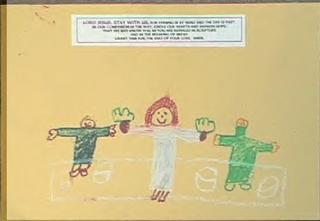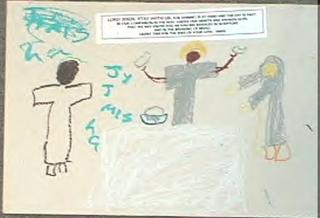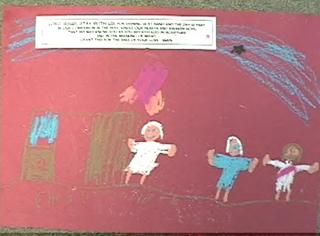When you are shopping for a children’s Bible, the first thing you will notice is the illustrations. On this basis alone, many Bibles for children do not merit a second look: the pictures are technically poor, prissily Victorian or cinematically heroic, or downright silly and cartoonish. Often, beauty and wonder seem to be of little concern to the author, illustrator and publisher. There is a reason for this.
The typical “Children’s Bible” published in the US grows out of the conservative Christian approach to Scripture. This leads the adapter and illustrator to focus on two goals: making sure that the reader learns the
facts of the story (regardless of tone, style, narrative voice, or context), and pointing out the
lesson (moral or doctrinal) embedded in the story. Under this agenda, editors normally adapt and expand the story, adding dialogue, description, and explanation; a didactic, “grown-up” narrative voice; or sometimes rhyme or whimsy, even rollicking buffoonery—all in order to help the child find the story accessible, inspirational, exciting, and fun. At its most extreme, the agenda of the Bible churches saturates the child's imaginative world with Bible formulas that never invite risk-taking with the story, or silence in the presence of mystery.
Children’s Bibles predictably consist of a standard selection of stories, drawn from those parts of the scriptures that occur in narrative form in the Bible itself. The problem is that not everything of importance in Scripture appears in the original texts in the form of narrative. Not even all the
story of Scripture appears in Scripture itself in the form of narrative. Scripture contains a repeated pattern of exile and return … alienation and reconciliation … loss and restoration. Children’s Bibles establish this pattern in the stories of the Garden of Eden, the sagas of Abraham, Jacob and Joseph (sometimes), and, of course, the Exodus; but they commonly lose sight entirely of its most complex restatement in the Old Testament—the destruction of Jerusalem, the Babylonian exile, and the promised return which still fails to establish a final and definitive reign of God.
In the scriptures, the experience of the Babylonian exile and its aftermath is recorded primarily in oblique forms: poetry, psalm, prophecy and lament. These texts are central to the spiritual and liturgical traditions of Jews and Christians alike, but because they are not narratives, they are essentially invisible in the standard children’s Bible. Thus the whole second act of Israel’s classic spirituality and worship—and the source of nearly all the imagery for the hope of Israel and the hope of the Messiah (as well as for the Church)—gets lost in a random collection of literary fragments, if indeed it appears at all.
In the New Testament, the narrative bias of children’s Bibles results in a distorted christology, where Jesus is seen, all the way to the end of the story, as an itinerant fixer-upper of people’s problems, rather than as saviour and redeemer of the world. The Resurrection becomes simply the last quick fix, rather than the dawn of a new covenant with a redeemed people. In those volumes that give a great deal of space to Acts, the Christ story itself almost disappears by the end of the volume, as the New Testament, like the Old, devolves into a more or less random collection of adventure stories and tales.
Typically, children’s Bibles completely overlook the Epistles, except perhaps for a few excerpts to embellish the stories of Paul. But it is in the Epistles that scripture probes the mystery of the Cross, and shows us the church’s continued participation in the life of Christ through prayer, praise, sacrament, and the community of faith. The total absence of these themes creates a serious, and utterly unacknowledged, disconnect for children—particularly children in the liturgical churches—between “Bible” and “church” (not to mention “Bible” and “my life”) that I suspect is behind much of the standard pattern of “outgrowing” faith around the age of 12 or 13. And the omission of Revelation is simply a cop-out. If Scripture is our basis for the claim that “Christ has died; Christ is risen; Christ will come again,” then our Bibles for children had better come to grips with the end of the story, especially at a time when popular culture is increasingly saturated with neo-gnostic millennialism.
It takes effort to find a children’s Bible that respects both the child and the Scriptures. Over the years I have been pleasantly surprised to find, sometimes in the oddest places, several that I can recommend highly. Each has different strengths and will appeal to children of different ages, temperaments and tastes. Tellingly, only one of them originates in the US. Like any other books, children’s Bibles go in and out of print, but thanks to the Internet it is possible to find nearly any of them—new or used—at almost any time.
The Lion Bible for Children, retold by Murray Watts, with illustrations by Helen Cann (Oxford: Lion Publishing, 2002) is a hefty volume, sized and shaped like a traditional children’s Bible, but excitingly innovative in its broader range of content and its thoughtful incorporation of scriptural and liturgical symbolism. The text makes a real effort to include material from the psalms, prophets, and epistles, and generally sticks closely to the words of scripture, though Murray Watts too often inserts an unnecessary narrative voice (“then something extraordinary and mysterious happened … something that changed Jacob forever”), especially at the beginnings of chapters. Helen Cann’s watercolors (with pencil details) are stylized and decorative without sacrificing the realistic details of facial expression and gesture that give characters individuality and life. Each two-page spread contains not only at least one large, full-color picture, but also a pair of marginal borders, that reflect the themes of the stories. The borders feature such images as stars, mountains, desert rocks, thorn bushes, flowering branches, waves of water, ears of wheat, and many more, and they unobtrusively serve to establish a symbolic framework for the story in progress. The border changes with each page turn, but each design reappears several times over the course of the book. One can imagine a thoughtful child spending hours thumbing through the volume to spot where the borders repeat themselves, and gaining, through this process, an intuitive sense of the basic symbolic language of scripture.
The best all-round version of the Bible for confident readers, 9 and up. The Reader’s Digest Bible for Children, by Marie-Hélène Delval (Joshua Morris Publishing, 1995) was originally published in France. The pictures are softly colored and gentle, with short, stocky figures with large heads—but not at all cartoonish or whimsical. Wensell, a Spanish artist, uses watercolor washes to bathe his scenes in miraculous, evocative light. He is especially good at wind and water, and often achieves wonderful emotional power by the use of unusual perspectives. The story is printed in short lines, at a very accessible reading level, and it is, almost always, simply Scripture: it has the terseness, the evasiveness, the mystery, of the ancient stories. For ages 7 to 10 (or older, for reluctant readers or simply for the beautiful art), or for reading aloud with younger children.
The best Bible for elementary-school children; unfortunately, it is now out of print. Tomie DePaola’s Book of Bible Stories (Putnam, 1990) is the one edition of American origin on this list. Tomie de Paola (a Roman Catholic who grew up in New England) needs no introduction: in all of his work, both text and illustrations are gentle, dignified, and beautiful, without ever being saccharine or sentimental. The text here consists of selections from the New International Version, with some simplifications. This collection is briefer than the Reader’s Digest Bible, and is
excellent for reading aloud with younger children, or for independent reading by early readers up to age 8.A Family Treasury of Bible Stories by Roberto Brunelli (Harry N. Abrams, 1997), a translation of an Italian edition, achieves its considerable impact from the stunning illustrations by Mikhail Fiodorov. Fiodorov draws inspiration primarily from Russian ikons, Byzantine art, and early Italian Renaissance painting. He is at his best in portraying the transcendent and mysterious, especially his angels, his depictions of the Transfiguration and Pentecost, and his closing spread on “The End of Time.” In other words, he is superb in just the sorts of images that most children’s Bibles either do not attempt, or attempt with painful or laughable results. For this alone the book is worth the price. The text, however, is somewhat pedestrian, resorting to uninspired paraphrase and unnecessary interpretation where a simple translation would have better served the book’s deeply suggestive illustrations.
Good for ages 8 to 12, especially children who are captivated by images of other worlds. The Children’s Illustrated Bible, by Selena Hastings (Dorling Kindersley, 1994) fills a different need. Dorling Kindersley, a British publisher, excels at making factual information clear and accessible to children, with photographs and maps as well as illustrations. The DK Children’s Bible includes the story line but concentrates on providing cultural, historical, and archaeological information in abundant sidebars on every page. Difficult to use for reading aloud, because of the preponderance of notes and sidebars, this book is
an ideal choice for the 8- to 12-year-old who is more drawn to facts and information than to emotionally stirring stories or visual images.
Stories from the Bible, illustrated by Lisbeth Zwerger (North-South Books, 2000), unlike the other Bibles reviewed here, is more text than illustrations. The page design is spare and clean, with the words taken directly from the King James Bible. The drawings and marginal decorations by Austrian artist Zwerger are typical of her quiet, idiosyncratic, highly sophisticated style. Competent readers will appreciate the opportunity to go deeply into the text; the pictures require children to be open to visualizing the Bible in ways that have little in common with the usual Sunday school images or stained-glass windows.
For serious readers aged 10 and up.
Words of Gold: A Treasury of the Bible’s Poetry and Wisdom, by Lois Rock (Eerdmans, 1997) was originally published in Britain and is a valuable supplement to the usual “story” Bible. It is an anthology of over 50 selections from just those parts of Scripture most overlooked in children’s Bibles: the psalms, prophets, and wisdom literature; the teachings and parables of Jesus; the Epistles and Revelation. Brief and informative commentary on each page provides the connecting story line. The selections are taken from a variety of translations. The pictures are perfect: rich and warm, with hints of medieval manuscript illuminations and William Blake.
Outstanding supplement to other children's Bibles, for ages 8 and up.
The final volume in this article is not recommended, but is included because of its newness and as an illustration of how many different ways there are to mess up a children’s Bible.The Pilgrim Book of Bible Stories, with text by Mark Water and illustrations by Diana Shimon (Pilgrim Press, 2003) also originates in Britain. It describes itself as “the most complete color children’s Bible available,” with the deliberate aim of giving proportional weight to all the books and genres of the Bible. “Wisdom literature, prophecy, vision and parable are given as much space as historical adventure.” Unfortunately this admirable goal is carried out in a maddeningly flat-footed way, resulting in a kind of Cliff’s Notes version of the Scriptures. The text is reduced to the barest of summaries, and regularly overpowered by subheadings, isolated Scripture verses, sidebars, and introductory material that is intended to “reveal the developing thread of the story, linking history to interpretation, literature to life,” but more often simply tells the reader what to think. Within these extremely threadbare narratives, which stop and start with no connecting story line, precious space is squandered by the addition of material that often grossly violates the tone and style of the original story. For example, the Dry Bones story from Ezekiel begins, “God gave me this mind-boggling vision. I just can’t get it out of my mind. ...”). Meanwhile, crucial plot elements are entirely dropped—for example, the Sabbath in the creation story; the blessing that follows the binding of Isaac; the repentance of Nineveh in the Jonah story. The illustrations are “extensively researched” and claim a high level of historical accuracy, but lack a sense of light, and the facial expressions, whatever the story, are almost always contorted, disturbed, or grim.
The book goes out of its way to include all the women’s stories in the Bible; it also consistently avoids the word “Lord,” and uses no male pronouns for God. In the New Testament, the word “Father” appears only in the Lord’s Prayer, which is buried under a subheading about the True Vine; the selection of parables includes none that involve kings, masters, or fathers. On the other hand, the ceremonial rituals of the Temple are described as verbally dictated by God (“God also told Moses that Aaron had to wear a special chest covering”); the book of Proverbs receives more explicit authorial approval than any other ethical teachings (“There is only one book in the Bible that was especially written for young people. It is the book of Proverbs”); and the narrative shows no embarrassment whatsoever with violence (“David took out his trusted sling. ... Whirl, wiz, splat. The stone found its target—Goliath’s forehead.”) There is no poetry, wonder, or mystery—no
depth—anywhere in this book, and precious little good news.
© 2005 by Gretchen Wolff Pritchard. All rights reserved. Labels: book reviews, parenting, Scripture, Sunday School









